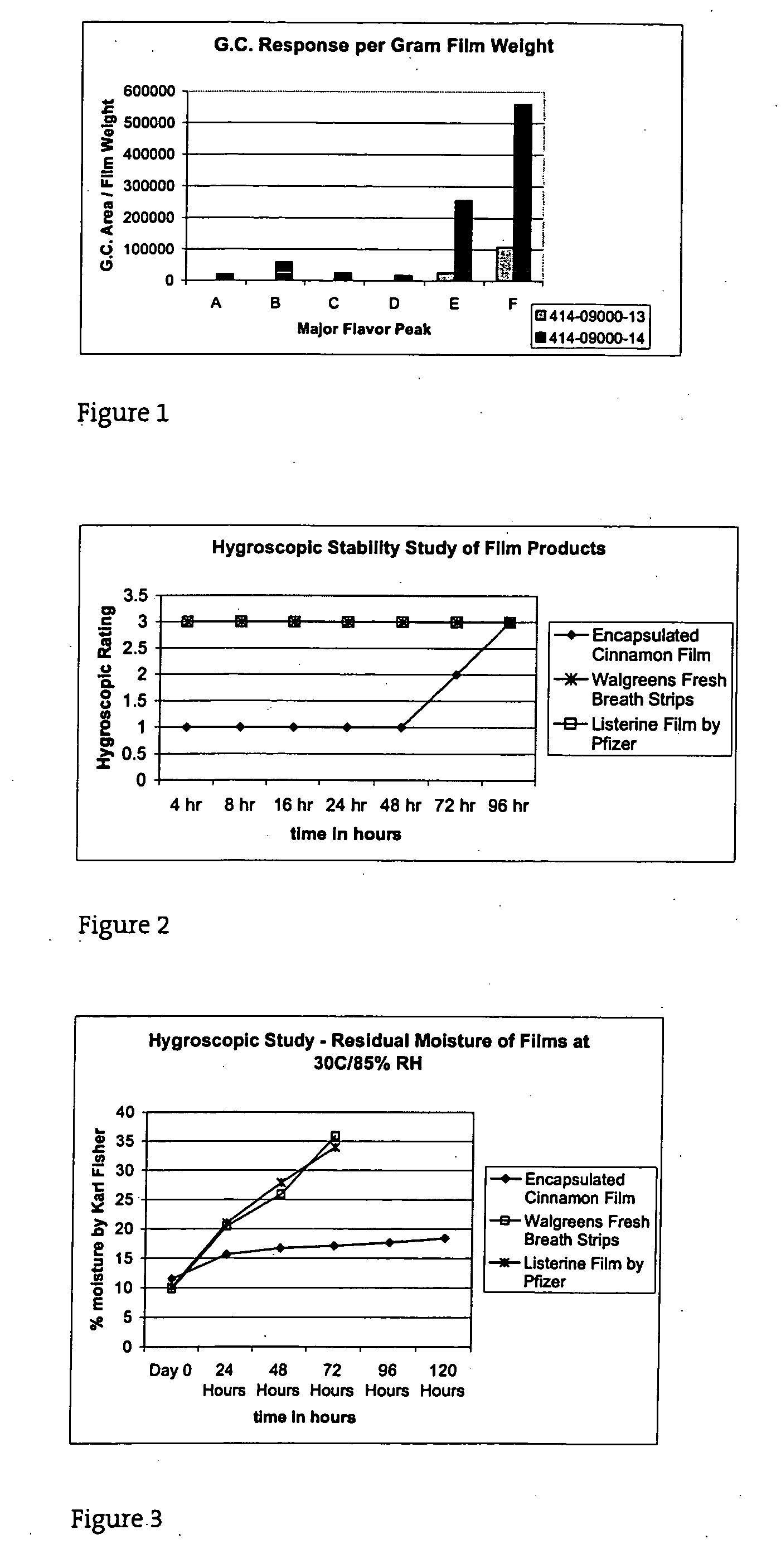Edible film
a technology of edible film and film body, which is applied in the field of edible film, can solve the problems of insufficient addition of ingredients, inability to fully express ingredients from the film, and pronounced problems, and achieve the effects of not easily friable, convenient film manufacturing, and convenient handling
- Summary
- Abstract
- Description
- Claims
- Application Information
AI Technical Summary
Benefits of technology
Problems solved by technology
Method used
Image
Examples
example i
[0085] A mono-layer hydrocolloid matrix containing encapsulated flavouring agents was prepared as follows:
Encapsulated Flavouring Agents:
[0086] A solution was made by adding 2.0 grams of Menthol Carboxamide and 5.0 grams deionized water into 40 grams Cinnamon Oil. This solution was mixed with 53.0 grams of Flavorburst® Dry Protein Encapsulate (Givaudan) for 30 minutes. Flavouring agents were absorbed into Flavorburst® after 30 minutes and a dry encapsulated powder was formed.
Polymer Solutions:
Starch Solution
[0087] 10 grams of Ultra-Sperse® A and 10 grams Textra® Plus were added to 180 ml of deionized water with high shear mixing until a clear solution was formed.
Protein Solution
[0088] Heat 70 ml of deionized water to 40° C. Slowly add 30 grams of Fish gelatin mix with slow agitation until gelatin is dissolved. Cool to 30° C. and maintain temperature.
[0089] Coating Solution:
Starch Solution 53 gramsProtein Solution 35 gramsSorbo Sorbitol Solution2.2 gramsPolysorbate 800....
example ii
[0092] A mono-layer hydrocolloid matrix containing encapsulated flavouring agents was prepared as follows:
Encapsulated Flavouring Agents:
[0093] A solution was made by adding 2.0 grams of Menthol Carboxamide and 5.0 grams deionized water into 40 grams Peppermint Oil. This solution was mixed with 53.0 grams of Flavorburst® Dry Protein Encapsulate for 30 minutes. Flavouring agents were absorbed into Flavorburst® after 30 minutes and a dry encapsulated powder was formed.
Polymer Solutions:
Starch Solution
[0094] 10 grams of Ultra-Sperse® A and 10 grams Textra® Plus were added to 180 ml of deionized water with high shear mixing until a clear solution was formed.
[0095] Heat 70 ml of deionized water to 40° C. Slowly add 30 grams of Fish gelatin mix with slow agitation until gelatin is dissolved. Cool to 30° C. and maintain temperature.
[0096] Coating Solution:
Starch Solution 44 gramsProtein Solution 44 gramsSorbo Sorbitol Solution2.2 gramsPolysorbate 800.8 gramsEn...
example iii
[0099] A multi layer hydrocolloid matrix containing encapsulated flavouring agents was prepared as follows:
Encapsulated Flavouring Agents:
[0100] A solution was made by adding 2.0 grams of Menthol Carboxamide and 5.0 grams deionized water into 40 grams Cinnamon Oil. This solution was mixed with 53.0 grams of Flavorburst® Dry Protein Encapsulate for 30 minutes. Flavouring agents were absorbed into Flavorburst® after 30 minutes and a dry encapsulated powder was formed.
Polymer Solutions:
[0101] 10 grams of Ultra-Sperse® A and 10 grams Textra® Plus were added to 180 ml of deionized water with high shear mixing until a clear solution was formed.
[0102] Heat 70 ml of deionized water to 40° C. Slowly add 30 grams of Fish gelatin mix with slow agitation until gelatin is dissolved. Cool to 30° C. and maintain temperature.
[0103] Coating Solution:
Starch Solution 48 gramsProtein Solution 48 gramsSorbo Sorbitol Solution3.0 gramsPolysorbate 801.0 grams
[01...
PUM
| Property | Measurement | Unit |
|---|---|---|
| Mass | aaaaa | aaaaa |
| Mass | aaaaa | aaaaa |
| Mass | aaaaa | aaaaa |
Abstract
Description
Claims
Application Information
 Login to View More
Login to View More - R&D
- Intellectual Property
- Life Sciences
- Materials
- Tech Scout
- Unparalleled Data Quality
- Higher Quality Content
- 60% Fewer Hallucinations
Browse by: Latest US Patents, China's latest patents, Technical Efficacy Thesaurus, Application Domain, Technology Topic, Popular Technical Reports.
© 2025 PatSnap. All rights reserved.Legal|Privacy policy|Modern Slavery Act Transparency Statement|Sitemap|About US| Contact US: help@patsnap.com

